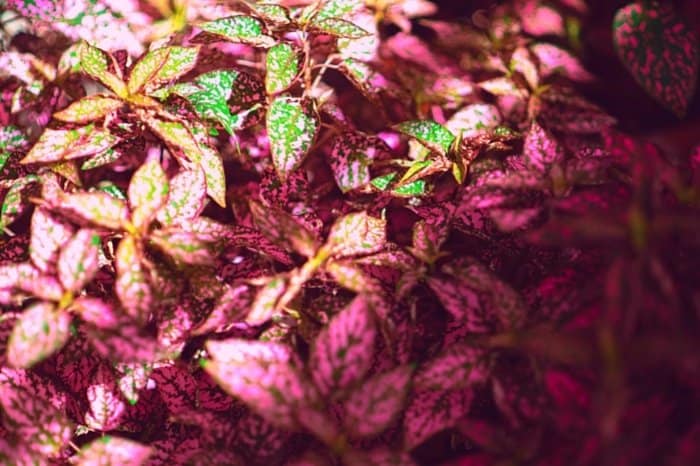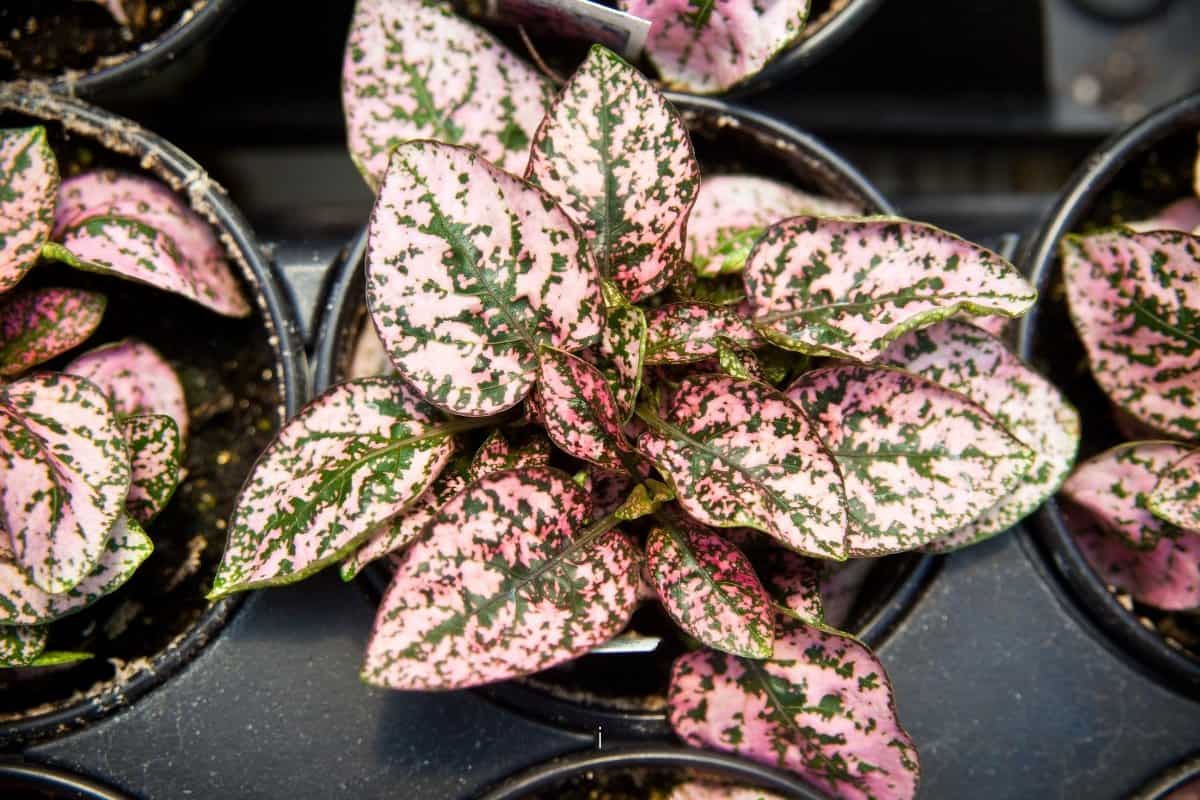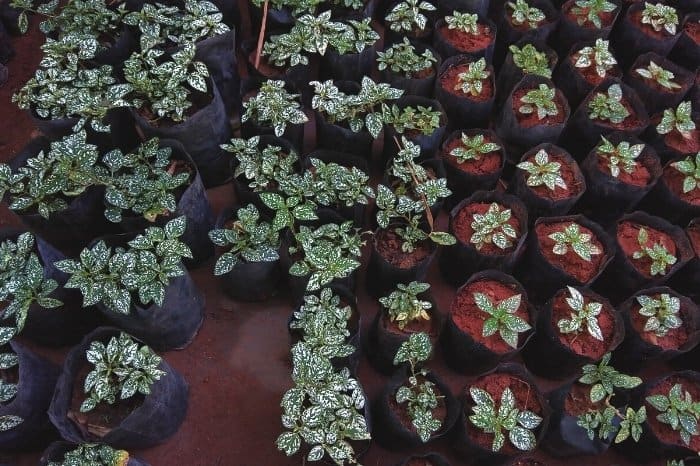Last Updated on December 28, 2021 by Cristina
Are polka dot plants perennials or annuals? Do they overwinter and regrow again in the spring, or do they die and need to be replanted again?
The polka dot plant, commonly referred to as freckle face, is an exceptional decorative ornamental plant. It has stunning foliage that makes it so popular in landscaping design. It is also grown as a houseplant providing a beautiful view in your home.
What Is Polka Dot Plant?
Polka dot plant is scientifically known as hypoestes sanguinolenta. It belongs to the hypoestes genus with over 100 species. It is native in Madagascar but gross worldwide. It can grow up to 3 feet tall, but the commercially produced ones r smaller in suitable for indoors.
The standard varieties grow between 0.5 to 1.5 ft in height with the same width. These plants are sensitive to frost and very gently and won’t grow well below 55 degrees.
A polka dot plant is called so because they are dotted with freckles of different colors and shades. This plant produces small insignificant purple polka dot flowers. These tiny lavender-colored flowers are a sign of the end cycle of the Hypoestes plants.
After the flowering, the polka dot plant goes dormant or dies. This is a significant drawback of these lovely plants. However, if you want to prolong the plant’s lifespan, read on to see how you can manage it.
Are Polka Dot Plants Perennials Or Annuals?
Depending on where you’re growing your polka dot plants, they can be both animal or perennial plants. They can be grown in USDA zones 3 to 10 indoors as perennials and outdoors as annuals. When produced outside, they tend to grow bigger, reaching up to 1 to 1.5 ft tall.
Regular pruning is critical for both perennial and annual polka dot plants. This plant loves attention and regular grooming to keep it strikingly beautiful every time. You can control its growth size through regular pruning and pinching back, making it more compact and showy. It also keeps the plant from getting too leggy and instead encourages a more bushy look.
Hypoestes thrives in moist soils that drain well. They also require just the right amount of water but don’t thrive in soaked soil. Constantly water them thoroughly, sprinkling the leaves with water occasionally. If you overwater them, the leaves will go yellow and starts to drop. Dropping of leaves could also mean that the plant lacks enough water. So be careful how are you water it.
Outsidepride Hypoestes Splash Rose Plant Seed – 200 Seeds
Polka Dot Plant Lifespan
Polka dot plant has oval leaves covered in spots of different colors. The most common ones have green leaves with pink spots, but the colors can range from white to beige to red and many other shades of pink and purple. Compared to the foliage, the polka-dotted flowers are tiny and, in most cases, not noticed.
Typically the lifespan of a polka dot plant is a single year, and the plant dies off after flowering. However, this depends on a variety of growing climates. This plant can display perennial or annual characteristics in different seasons. The most important thing is to know what zone you are in to tell if your polka dot plant is annual or perennial.
The death of this plant is triggered by its natural life cycle of flowering. However, if you remove these polka dot plant flowers immediately after they die, you can prolong your plant’s life. Pruning ensures that the nutrients are sent from the flowers to the foliage, encouraging an extended life cycle.
Click here to Know What Does Tarragon Look Like?- An Inside Look
Tips To Extend The Life Of Your Polka Dot Plant Perennial Or Annual
-
-
Pinch off the flowers as they develop to encourage leaf growth and delay plant death.
-
Prune your polka dot plant regular to promote a bushy appearance and prevent flowering.
-
Fertilize your polka dot plant regularly. Feed your outdoor plants once every month and your indoor plants every other week.
-
Read more about When To Plant Columbine Seeds – A Guide
Polka Dot Plant Varieties You Can Grow Perennials Or Annuals
Breeders have developed many polka dot plant varieties that differ in the color of their leaves. Some have green mottled spotting, while others have dotted color hues. There are purple, scarlet, white, and lavender speckled leaves.
The splash series comes in various colors with a green base leaf and mottled white, pink, red, or rose splashes. There’s also confetti series with spotting-shaped dots more sparsely scattered than those of the splash series.
Here are the different varieties that you can grow:
-
White. The white leaves have a particular green spotted pattern
-
Confetti. The leaf color options range from pink, red, burgundy to White. They are a small variety that thrives.
-
Purpariana. The leaves of this plant have a deep purple hue.
-
Pink dot/ Splash. The leaves a variety of pink and red sports against a darker green background.
-
Pink Brocade. The leaves of this variety a spotted with soft mottled pink splashes of color on a green background.
-
Carmina. This variety has foliage covered in bold red freckles on deep green background.

Final Thoughts
The polka dot plant has striking foliage perfect for ground cover or filler outdoor gardens. They also do well indoors, providing a beautiful splash of color for rooms in need of a bit of brightening.
It is now easy to plant your polka dot plants perennials or annuals, depending on your USDA hardiness zone. Although some polka-dot plants may seem to have a relatively short life cycle depending on the climatic conditions you grow them under; you can extend its life by following are covered tips.
Do not shy away from growing this beautiful lift plant among the few planted for their leaves, not flowers. No matter its life cycle, you still get to enjoy its beauty.
How about you share with us your tips for growing polka dot plants and how you prolong their life cycle? Have a happy hypoestes gardening, won’t you?
Caroline is a gardener who loves to get down to the nitty–gritty of gardening. She proudly proclaims herself as a ‘dirt worshipper‘ and can often be found deep in the garden, covered in soil and singing to her plants. As a self–proclaimed ‘plant whisperer‘, Caroline believes that plants need love and attention just like any other living thing, and she loves to give them both. When she‘s not tending to her garden, you can often find her researching the latest gardening trends, or teaching others how to make their gardens thrive




